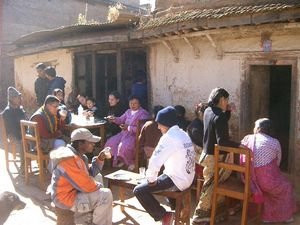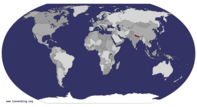Advertisement
Published: December 25th 2007

 Always a tea shop
Always a tea shop
The little village near the temple had a Nepali tea shop where everyone enjoyed snacks such as fried garbanzo beans and curried potatoes. The drivers were already beginning to wonder at the quantity of food that our older women were able to intake during the course of the trip. Just two days after the big bhoj we had a chance to take a journey out of the Kathmandu Valley. The town of Dolkha is north east of Kathmandu, and is a gateway to the mountain regions that lie beyond it. Ben’s nephew Dipen has been living and working there as the manager of the local hospital which serves the rural population in that area. Dipen’s mother is Ben’s first cousin yet both she and her husband are of the older generation. Neither of them ever have an opportunity to take a trip, lacking both the financial resources as well as the intrinsic motivation to do so. They are also both in poor health so anything involving walking must be done with care. When Ben suggested the trip to Dolkha, however, they were enthusiastic about the chance to see where their son was working and arrangements were made to bring them along.
The trip to Dolkha took place in a rundown van which could comfortably seat 12, while we were altogether 17 including the driver and the conductor. Several of the older women in Ben’s family came along with us, and it turned out to be something of a pilgrimage

 View and views
View and views
During the entire drive we were treated to fabulous views of the Himalayasfor them, as we were able to visit two important temple sites during the trip. The older women who accompanied us are widows, mostly of limited financial resource. For these women life is not what they bargained for, having followed the rules of their society with the expectation that the definition and integrity of those rules were something permanent that they could count on. As tradition is changing and modernity is crashing into Kathmandu with the force of a tsunami, they are constantly facing challenges as to what they can expect and what is expected of them. Hardly leaving their houses, and never leaving the city, a trip like this was an exciting adventure for them outside of the normal rhythm of their lives. It was important to Ben that these women come with us and that they enjoyed themselves as much as possible. To him they represent the sacrifice and compassion that was part of the lifestyle in which he was raised as a child. Many of these women took care of him at various stages of his life, and he was anxious to offer them some happy memories.
With typical Nepali efficiency, it took us more than

 A cramped journey
A cramped journey
Lilia was nervous about how high we were driving. Ben gave her his mp3 player and she spent many happy hours listening to hindi music while we drove. We all had to give her credit for being a fantastic traveler. The trip to Dolkha and back was long and winding, and she hardly complained despite being cooped up in a crowded van for hours. 2 hours just to leave the valley, as we had to drive across town for a road permit, and then back in the other direction to actually make our departure. It is always amazing to leave the Kathmandu valley, not just because of the imminent escape from smog, traffic and crowds, but also because the intensity of the landscape is immediately apparent. As the ascent onto the long winding roads begins, the views become expansive. The road is almost never flat again, steeply climbing or descending, with precipitous hillsides in one direction or the other. After passing through one ugly cement ridden and dirt covered roadside town, we were happy to see that the subsequent villages were for the most part pleasant and clean.
Our first stop was an ancient temple site perched high upon a typical Nepali hillside, meaning that it was incredibly high up, and the road reaching it was steep and precarious. The family performed a brief puja there, drank some tea, made use of the toilet facility and then moved onwards. The issue of toilets is always an interesting topic of conversation in Nepal. Toilet facilities can be few and far between, and often it

 Bhagawati Temple
Bhagawati Temple
Our first temple site was another opportunity to light lamps and perform puja for departed loved ones. is much more comfortable and sanitary to go in a field rather than brave the small dank and smelling toilets that are typical of much of Nepal. Ben is frustrated and disgusted by the toilet situation in Nepal and complains about it regularly. This viewpoint he inherited from his father, who while lacking any formal education, has always been ahead of others in his generation in his thinking and outlooks. Ben’s father was one of the first of the old Newars to put toilets with running water on each floor of his house. Toilets are considered impure by most Nepalese, and so are usually stuck in some far dim corner of the property, poorly lit, and soaking wet. Ben’s father saw that clean comfortable toilet facilities were an important part of a well run household and was able to upgrade the standards in their home accordingly. Interestingly, when he visited the US, he was always keen to inspect the toilet first wherever we went. The toilet at the Bhagawati temple was clean enough in that it was not covered with excrement, but nonetheless it was uncomfortable, wet, dark, and smelly. Lilia has commented frequently on the bathroom situation as well,

 Lilia and Dipen
Lilia and Dipen
Lilia with her cousin Dipen. I just added this because it is sweet. and has been very observant about the differences in the bathrooms at the various places we have visited.
Our crew of older ladies passed the time in the van by snacking non-stop. They had dried sour fruit, chips, rice flour donuts, chewing gum, raisins and nuts. We snacked not just in the car but we also stopped frequently. Each time we stopped we had something to eat or drink and provided these snacks to our drivers as well. By the end of the trip they were absolutely amazed by the fact that our group was constantly eating. After our first tea stop we made another stop for lunch at a local dal bhat stand which seemed to have scenic views overlooking the river. We enthusiastically made our way to the back of the building with hopes of eating near the windows, only to find that the sewage and trash which was being dumped into the river there stank up the whole area. Fortunately the food was good. The town itself was a way station for goods from China on their way to Kathmandu. Our crew spent some time shopping for various items that were cheaper here than in town.

 Many ways to travel
Many ways to travel
In Nepal the buses are so crowded that there is usually a group of people sitting on the top with the luggage. While this would be exciting enough on a flat straight road, imagine winding around mountain curves with expansive views of Himalayan valleys in all directions. I was sad to see that the town itself was mostly a ratty little bus and truck stop, situated as it was on the edge of two rivers, and surrounded by luscious valleys. With a little vision and investment a town such as that could be developed into something beneficial for locals as well as visitors.
The rest of the journey was a non-stop ascent around winding twisting curves and bends that eventually landed us in the town of Dolkha. Dolkha is a charming little town. It was much nicer than I had expected as somehow I had the vision of it as a little truck stop type of shanty that served the population of villages around it. Instead it was a traditional village with two lovely old temples, and outstanding views of the Himalayas as well as the surrounding valleys. The hospital in which Dipen works has the best views of the mountains in the entire village. Unfortunately our photographs don’t reflect how grand and starkly beautiful it really is. We had raced to the hospital to get the sunset views but missed that chance to take a good photo by a just a few minutes.
In

 Dholka views
Dholka views
The view of the mountains from Dolkha village. This was actually right at sunset but the photo didn’t capture the effusive glow of the mountaintops as the sun sped away towards the westthe morning we had a brief tour of the hospital. Serving the local villages, it treats more than 70 patients per day. It is the only hospital in the area for people who need surgery, and they are able to perform appendectomies, c-sections, and hernia surgeries. When I inquired about the finances of the hospital I was glad to learn that doctor visits cost only 25 rupees (40 cents) with follow ups being about 10 rupees. It was thought provoking however when Dipen mentioned that the hospital is not yet breaking even though they are expecting that it might as the patient load increases. A woman who needs a c-section has to pay almost 15000 rupees there-considerably less than what they would pay in Kathmandu. Considering the fact that the patients who come there are villagers, and many of them low caste, it seems very likely that having to pay 15000 rupees for surgery is financially devastating for their families. I also considered how the level of care would be affected for patients as the patient load increases every day. I was wondering how a hospital in such a low resource area could possibly “break even” while still providing affordable

 Hospital Setting
Hospital Setting
Mountain view from the hospital grounds. Again the photo representation is poor compared to the actual image. and compassionate care for people such as these and should such a goal even be contemplated. Is it not circumstances such as these that make clear the need for health care which is provided by the government or the world community? Unfortunately we didn’t have time to stay and investigate further, as the older people with us needed to return to Kathmandu.
Lilia actually cried on the road and refused to get into the car when it was time to leave Dolkha. Secretly I wanted to cry too, as the town was much lovelier than I had expected and the thought of another entire day spent in the car winding around roads back to smog and chaos was not very appealing. At least we now know that Dolkha is someplace that we will definitely return to spend more time, both to explore the villages and to learn more about the health care options that are being developed at the hospital there.
Advertisement
Tot: 0.046s; Tpl: 0.014s; cc: 7; qc: 23; dbt: 0.0226s; 1; m:domysql w:travelblog (10.17.0.13); sld: 1;
; mem: 1.1mb
















Bishwas
non-member comment
What would you write
Good Travel Blog. Informative as well as Analytical. Just wondering how powerful would be your expression whence you travel farther from Dolakha, anywhere in rural regions.